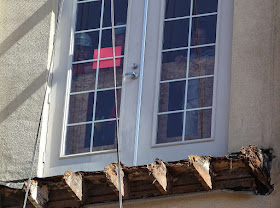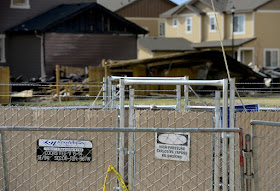 Crews work to stabilize a sinkhole and clear out nearby hazards after heavy rains in December 2015. The City shared this photo with The Review in March 2016, before an Oak Creek homeowner filed a lawsuit over the repairs. (LO Engineering Department via Portland Tribune)
Crews work to stabilize a sinkhole and clear out nearby hazards after heavy rains in December 2015. The City shared this photo with The Review in March 2016, before an Oak Creek homeowner filed a lawsuit over the repairs. (LO Engineering Department via Portland Tribune) LAKE OSWEGO, Ore. (THE REVIEW) — An Oak Creek neighborhood resident has filed a federal lawsuit against the City of Lake Oswego, seeking compensation for alleged property damage caused by an extensive project last year to shore up a failing stormwater pipe.
Rob Amsberry, a City stormwater engineer, and Emery & Sons Construction Inc. are also named as defendants in the federal lawsuit, which was filed April 19 in U.S. District Court in Portland.
Lola Amacher’s lawsuit claims that when contractors acting on behalf of the City restored the landscaping and irrigation system in her backyard after completing repairs to a nearby stormwater pipe, they installed a new irrigation system that uses more water than before and leaks water into the ground even when shut off.
As a result, the lawsuit says, Amacher has been hit with higher water bills and her basement has repeatedly flooded in the months since the project was completed. The lawsuit also claims that the City did not offer fair compensation for the intrusion onto Amacher’s property while the repair work was being done on the pipe.
Additionally, the lawsuit claims that the City denied a personal injury claim filed by Amacher after she allegedly fell and was injured due to the “uneven and unstable condition” on her property during the project.
The lawsuit seeks unspecified financial compensation and punitive damages from the City. It also seeks compensation for attorney fees and asks that the City be rquired to repair the irrigation system by identifying and stopping the source of the leak.
City Engineer Erica Rooney told The Review last week that the City was aware of the lawsuit, but she declined to comment further.
The municipal stormwater line in question runs underneath a Westlake property located directly south of Amacher’s home. The underground pipe is adjacent to the fence that divides the two properties’ backyards. (The dividing line between the properties also aligns with the dividing line between the Westlake and Oak Creek neighborhoods.)
In the middle of an exceptionally rainy winter season in late 2015, a large sinkhole opened up along the back edge of the property belonging to Amacher’s neighbor, swallowing part of both backyards along with the fence that divided them and threatening to destabilize several nearby trees.
Amacher’s lawsuit states that the sinkhole opened “on or around” Nov. 15, 2015, although City officials told The Review last year that the owners of the Westlake property reported the sinkhole on Dec. 10. City staff examined the sinkhole and determined that it had been triggered by a partial collapse of the aging aluminum stormwater pipe.
“The straw that broke the camel’s back was the high flows we had in there,” Amsberry told The Review in March 2016. “I think what happened is the bottom was corroded away and the water scoured out the soils underneath it so it didn’t have any support, so it started folding in on itself, and then it started taking all the soil with it once it finally collapsed.”
As an emergency solution, the City enlisted Emory & Sons Construction to stabilize the hole, install a temporary replacement pipe and remove the affected trees. The contractor had the necessary supplies on hand because of work being done on the Lake Oswego-Tigard Water Partnership at the time, but only for a temporary fix.
The collapsed pipe segment was part of a 350-foot length of pipe that ran under several adjacent properties, Amsberry told The Review last year, and an inspection revealed that the rest of the pipe was in equally bad shape and could collapse in the same way at any time.
Rather than digging a trench through several additional backyards, the City opted to line the inside of the pipe with a stronger HDPE plastic pipe, which could be pushed through piece by piece from an access point at the stabilized sinkhole. The new pipe was installed in early March 2016, and contractors then refilled the hole and restored the yards.
According to Amacher’s lawsuit, Amsberry offered Amacher $6,800 on behalf of the City in May 2016 as compensation for the use and occupation of her property during the project. Amacher declined, the lawsuit states, because the project was still ongoing at the time and she felt that she could not gauge the full extent of its impact on her property. The offer expired on Aug. 8, 2016, the lawsuit says, and Amacher was subsequently told it was no longer available.
The Review sought clarification last week about the City’s compensation policy and how it would apply in this case, but Rooney declined to comment, citing the ongoing litigation.
The lawsuit states that Amacher noticed the higher water usage by her new irrigation system during the project and notified the City, and that she continued to ask about it after the work was finished. The lawsuit states that the City made additional visits to try to solve the problem, but the high water bills continued.
In January 2017, the lawsuit states, Amacher found that her basement had flooded and that the water appeared to be coming from her backyard. The lawsuit states that her basement had never flooded during her prior 10 years living on the property, and that she had to install a sump pump and drainage system to prevent further flooding,
The lawsuit was filed by attorneys Neil Olsen and Brian Best of the Lake Oswego law firm Rathbone Barton Olsen PC. Last week, Best declined to comment for this story.









































